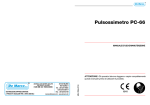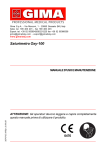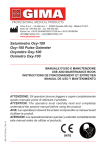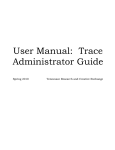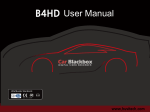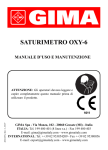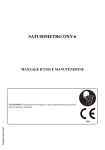Download Saturimetro Oxy-100 Oxy-100 Pulse Oximeter
Transcript
Gima S.p.A. - Via Marconi, 1 - 20060 Gessate (MI) Italy Italia: tel. 199 400 401 - fax 199 400 403 Export: tel. +39 02 953854209/221/225 fax +39 02 95380056 [email protected] - [email protected] www.gimaitaly.com Saturimetro Oxy-100 Oxy-100 Pulse Oximeter MANUALE D’USO E MANUTENZIONE USE AND MAINTENANCE BOOK M34342-M-Rev.1.05.12 ATTENZIONE: Gli operatori devono leggere e capire completamente questo manuale prima di utilizzare il prodotto. ATTENTION: The operators must carefully read and completely understand the present manual before using the product. 0476 ITALIANO 2 1. Sicurezza 1.1 Istruzioni per un utilizzo sicuro - Controllare l’unità principale e tutti gli accessori periodicamente per assicurarsi che non vi siano danni visibili che possano alterare la sicurezza del paziente e la correttezza della misurazione. Se si dovesse riscontrare un qualsiasi tipo di danno, smettere di utilizzare il saturimetro. - La manutenzione necessaria deve essere effettuata SOLO da personale qualificato. L’utente non è autorizzato alla manutenzione. - L’ossimetro non può essere utilizzato con macchinari non specificati nel presente manuale. 1.2 Pericoli - Pericolo di esplosione—NON utilizzare il saturimetro in ambienti con presenza di gas infiammabili come alcuni agenti anestetici. - NON utilizzare il saturimetro quando il paziente è sotto analisi MRI e CT - Per lo smaltimento del prodotto si devono seguire le leggi locali. - L’utilizzo continuo e prolungato del dispositivo nella medesima posizione può causare sensazione di fastidio o dolore, specialmente per pazienti con microcircolazione insufficiente. Si raccomanda di non applicare il sensore nella stessa posizione per più di 2 ore. Se si riscontra una qualsiasi condizione di anormalità, cambiare la posizione del sensore. - In alcuni casi la scelta della posizione del sensore deve essere fatta con prudenza. Il sensore, ad esempio, non deve essere applicato su edemi o tessuti molli. 1.3 Punti importanti - Tenere il saturimetro lontano da polvere, vibrazioni, sostanze corrosive, materiali esplosivi, alte temperature e umidità. - Se il saturimetro si dovesse bagnare, smettere di utilizzarlo. Quando viene spostato da un ambiente freddo ad uno caldo e umido, non utilizzarlo immediatamente. - NON premere i tasti del pannello frontale con materiali appuntiti. - NON è permesso disinfettare il saturimetro con vapore ad alta temperatura e pressione. Fare riferimento al presente manuale per le istruzioni su pulizia e disinfezione. ITALIANO 3 2. Descrizione generale 2.1 come si presenta il prodotto Interfaccia dati e porta riservata Display Tasto di accensione / Indietro Tasto di navigazione Modalità/OK Richiamo / Retroilluminazione Connettore sonda SpO2 Display: mostra i valori dei parametri e il grafico SpO2 Tasti di navigazione: Alto/sinistra/aumenta: dalla schermata iniziale, premere questo tasto per visualizzare la frequenza cardiaca (PR) o l’indice di perfusione (PI). Quando ci si trova invece nella schermata di impostazione del sistema, premere lo stesso tasto per muovere il cursore verso l’alto o verso sinistra e regolare i valori dei parametri. Basso/destra/diminuisci: il suo funzionamento è del tutto simile a quello del tasto alto/sinistra/aumenta. ITALIANO 4 Modalità/OK: premendo questo tasto si cambia la modalità di visualizzazione e tenendolo premuto a lungo, appare la schermata del menù. Dopo aver terminato l’impostazione dei parametri, premere nuovamente questo tasto per confermare. Interfaccia dati: viene utilizzata per aggiornare i dati. Porta riservata: per un eventuale uso che dovesse rendersi necessario. Tasto di accensione/Indietro: premendo a lungo questo tasto si accende o spegne il dispositivo, mentre premendolo solo un istante si torna alla modalità precedente. Richiamo/Retroilluminazione: premendo a lungo questo tasto si richiama la schermata di SpO2, mentre premendolo per un solo istante si attiva/disattiva la retroilluminazione del display. SpO2: a questa porta si deve collegare il connettore SpO2 2.2 Struttura Il dispositivo consiste del corpo principale e di un sensore fotoelettrico o di una sonda SpO2. 2.3 Caratteristiche - Molto leggero e di dimensioni contenute - Display a colori OLED con differenti modalità e orientamento selezionabili - Misura accuratamente SpO2, frequenza cardiaca e indice di perfusione - Avvio automatico della misurazione dopo l’introduzione del dito - Spegnimento automatico dopo 8 secondi senza segnale - Allarmi visivi e audio - Indicatore batteria in esaurimento 2.4 Principali applicazioni e scopo del prodotto Il Saturimetro da dito è indicato sia per l’uso domestico che per l’uso ospedaliero. E’ in grado di monitorare l’SpO2, la frequenza cardiaca e l’indice di perfusione. ITALIANO 5 2.5 Caratteristiche ambientali Temperatura di lavoro: 5°C~40°C Umidità di lavoro: 30%~80% Pressione di lavoro: 70kPa~106kPa 2.6 Installazione batterie e supporto 1. Aprire il pannello posteriore con una moneta o con un cacciavite a taglio, come mostrato in figura 1. Figura 1 2. Prestando attenzione alla polarità, inserire tre batterie AA nell’alloggiamento, come mostrato in figura 2. Figura 2 3. Chiudere il pannello e bloccarlo. 4. fissare il supporto dell’apparecchio (figura 3 ). sul retro Figura 3 ITALIANO 6 3. Connessione sonda SpO2 Collegare la sonda SpO2 al connettore sulla destra del pannello etichettato con la scritta -SpO2-. Dopo aver acceso il dispositivo inserire un dito nella sonda (indice, medio o anulare con unghie di lunghezza appropriata) come mostrato nella figura seguente. Figura 5 - Esempio di utilizzo sonda SpO2 Istruzioni per l’utilizzo 1. Il dito deve essere posizionato appropriatamente e correttamente. 2. Non agitare il dito e mantenerlo a riposo durante l’utilizzo. 3. Non inserire il dito bagnato direttamente nel sensore. 4. Evitare di posizionare il sensore sullo stesso braccio su cui è installato un bracciale per la misurazione della pressione sanguigna o dove sia presente un dispositivo per infusione venosa. 5. Non permettere che qualcosa possa bloccare la luce emessa dal sensore. 6. Azioni energiche del paziente o un’eccessiva interferenza elettrochirurgica possono alterare la precisione della misurazione. 7. L’utilizzo di smalto o altri cosmetici sulle unghie può alterare il risultato della misurazione. ITALIANO 7 4. Utilizzo 4.1 Schermata iniziale Tenere premuto il tasto di accensione “ ” per 2 secondi per avviare l’oximetro, quindi inserire il dito nella sede apposita. A questo punto sul display appare la schermata iniziale c\ome mostrata in figura. Figura 6 - Schermata iniziale Descrizione schermata: “%SpO2” “99”: valore di SpO2 dove “99” e il valore in percentuale; “10:12:45”: ora corrente; “PR 65”: valore della frequenza cardiaca (65bpm); “ “ ”: indicazione dello stato della batteria; ”: icona memoria dati. Quando i dati sullo schermo diventano stabili, il dispositivo inizia a memorizzare automaticamente dati. Se l’icona non è presente significa che non vengono memorizzati i dati; “ “ ”: icona dell’allarme; ”: grafico dell’intensità della pulsazione; Nella parte sottostante appare invece il grafico. ITALIANO 8 4.2 Schermata valore PI Partendo dalla schermata iniziale, premere i tasti di navigazione / per cambiare schermata e visualizzare quella con il valore PI, mostrata qui di seguito. Figura 7 - Schermata valore PI 4.3 Altre modalità di visualizzazione Dalla schermata iniziale, premendo il tasto Modalità/OK si accede alle altre modalità di visualizzazione (come mostrato in figura 8A). Tasti di navigazione / : servono a spostarsi dalla schermata di osservazione PR (figura 8A) a quella di osservazione PI (figura 8B). Tasto modalità/OK : serve a spostarsi attraverso quattro schermate (mostrate nelle figure 6, 7, 8A e 8B). Figura 8A - Schermata osservazione PR 9 ITALIANO Figura 8B - Schermata osservazione PI 4.4 Indicazione dell’assenza di segnale Se appare a schermo il messaggio “no signal” (come mostrato in figura 9) controllare se la sonda è collegata correttamente e se il dito è nella posizione corretta. Figura 9 - Nessun segnale dalla sonda 4.5 Menù di impostazione Dalle schermate sopra menzionate, tenere premuto a lungo il tasto Modalità/OK per accedere alla schermata del menù delle impostazioni (mostrato in figura 10). Figura 10 - Schermata menù impostazioni ITALIANO 10 Descrizione schermata: “SETUP”: serve a impostare i valori dei parametri; “UPLOAD DATA”: serve ad accedere allo stato di uploading. 4.5.1 SETUP Dalla schermata del menù selezionare “SETUP” e premere il tasto OK per accedere alla schermata di impostazione del sistema di seguito riportata. Figura 11 - Schermata di Setup (A) Figura 11 - Schermata di Setup (B) Figura 11 - Schermata di Setup (C) ITALIANO 11 Istruzioni per l’utilizzo DATE: impostazione data 1. Quando il cursore si trova sul mese della data, premere il tasto OK per attivare il mese e il cursore inizierà a lampeggiare; 2. Premere i tasti di navigazione / per impostare il mese; 3. Premere il tasto Accensione/Indietro o Modalità/OK per confermare e uscire dall’impostazione della data. 4. La procedura per la regolazione di anno e giorno è identica a quella del mese. Il formato della data è il seguente: MM. dd. yy. NOTA: Le operazioni di impostazione degli altri parametri (quali l’ora, il contrasto, la suoneria d’allarme, ecc.) sono tutte uguali a quella descritta per la data. TIME: impostazione ora. CONTRAST: impostazione del contrasto del display LCD. ALARM SOUND: di default l’opzione si trova su ON e in tal caso il dispositivo è in stato di preallarme e a display è presente l’icona corrispondente in alto a destra. ALARM SpO2: impostazione allarme SpO2 il cui valore di default è del 90%. ALARM PR HI/LO: impostazione limiti superiore e inferiore della frequuenza cardiaca. Il valore di default è di 120 per il limite superiore e 50 per quello inferiore. PULSE SOUND: pulsante per l’attivazione del beep della pulsazione. REC INTERVAL: impostazione dell’intervallo di registrazione. Sono disponibili cinque opzioni: 1s, 2s, 4s, 8s e OFF. Quando si seleziona OFF ilo dispositivo non registra i dati della misurazione in tempo reale. ITALIANO 12 4.5.2 UPLOAD DATA Dalla schermata del menù, selezionare “Upload Data” e premere quindi il tasto Modalità/OK per accedere alla modalità di connessione (come mostrato in figura 12). Quando si trasmettono dati (valori SpO2 e PR) al proprio computer, mettere l’oximetro in modalità connessione. Figura 12 - Schermata stato connessione 4.6 Lista dati Dalla schermata iniziale, premere a lungo il tasto Richiamo/Retroilluminazione per accedere alla schermata della lista di richiamo dei dati. Figura 13 - Lista dati da richiamare 4.6.1 Richiamo dati Scegliere un elemento dalla lista di dati, quindi premere il tasto Modalità/OK e apparirà a schermo il grafico corrispondente, come mostrato in figura 14A. ITALIANO 13 Grafico SpO2 Grafico PR Figura 14A - Grafico dei dati richiamati Descrizione schermata: “SpO2”: il valore a sinistra sulle ordinate è il valore %SpO2; “12:50:35”: orario della misurazione; “2s”: intervallo di registrazione (in questo caso 2s); “PR”: il valore a destra sulle ordinate è il valore della frequenza cardiaca. Istruzioni per l’utilizzo: - Premere il tasto Modalità/OK per spostarsi tra le differenti schermate dati (vedi figure 14A, 14B, 14C). Grafico SpO2 Figura 14B - Grafico dei dati richiamati Grafico PR Figura 14C - Grafico dei dati richiamati ITALIANO - Premer il tasti di navigazione 14 / per vedere il grafico. - Premere il tasto di Accensione/Indietro per tornare alla lista dei dati. 4.6.2 Cancellazione dati Scegliere un elemento dalla lista dei dati e tenere quindi premuto a lungo il tasto Richiamo/Retroilluminazione . Appare quindi un’icona “ “ alla fine di questo elemento, come mostrato in figura 15. Figura 15 - Selezione dati da cancellare Dopo aver terminato la selezione dei record da eliminare, premere il tasto di Accensione/Indietro . A questo punto il dispositivo visualizza il messaggio “Delete all the marked records?” (Cancellare tutti gli elementi selezionati?) come mostrato in figura 16. Selezionare quindi “Yes” e premere il tasto OK per cancellare tutti gli elementi selezionati. Figura 16 - Cancellazione dati 15 ITALIANO 5. Specifiche tecniche A. Modalità Display: Display LCD monocromatico. B. Alimentazione richiesta: Voltaggio batterie: 3.6V~5.0V (3 batterie AA alcaline) Corrente di alimentazione: <50mA Tempo di lavoro continuo: >30 ore C. Misurazione SpO2: Intervallo di misurazione: 35% - 99% Precisione ±2% (per valori tra 75% e 99%) Precisione ±3% (per valori tra 50% e 74%) Limite di allarme di default: 90% D. Misurazione frequenza cardiaca: Intervallo di misurazione: 30 bpm - 240 bpm Precisione Frequenza cardiaca: ±2bpm o ±2% Limiti di allarme di default: Superiore 120bpm, inferiore 50bpm. E. Misurazione Indice di perfusione: Intervallo di misurazione: 0% - 20% F. Registrazione dati: Registrazione dati una volta ogni 1/2/4/8 secondi fino a 70 ore di registrazione. G. Tolleranza alle luci esterne: La differenza tra il valore misurato in condizioni di luce naturale al chiuso e in una stanza buia è inferiore a ±1%. H. Tolleranze alle interferenze esterne: I valori di SpO2 e della frequenza cardiaca possono essere misurati accuratamente dal simulatore di pulsazione dell’ossigeno. I. Dimensioni: 145 mm (L) x 74 mm (W) x 29 mm (H) - Peso: 210 g (batterie incluse) J. Classificazioni: Tipo di protezione contro shock elettrici: Dispositivo ad alimentazione interna Grado di protezione contro shock elettrici: Apparecchio di tipo BF Grado di protezione contro ingresso accidentale di liquidi : Apparecchio senza protezione contro ingresso accidentale di liquidi Compatibilità elettromagnetica: Gruppo I, Classe B ITALIANO 16 6. Accessori 1. Una sonda 2. Un supporto 3. 3 batterie AA 4. Un manuale utente 5. Un certificato di qualità 6. Un cavo dati (optional) 7. Software Oximeter Data Manager (optional) NOTA: Gli accessori potrebbero cambiare. Controllare nell’imballaggio che siano presenti quelli riportati nella lista dei componenti. 7. Riparazione e manutenzione 7.1 Manutenzione La vita media di questo apparecchio è di circa 5 anni. Al fine di assicuragli la vita utile più lunga possibile, seguire con scrupolo le seguenti istruzioni. A. Sostituire le batterie quando l’indicatore di carica batterie in esaurimento inizia a lampeggiare. B. Se non si usa il saturimetro per un lungo periodo, rimuovere le batterie. C. L’ambiente migliore per la conservazione dell’apparecchio è a una temperatura compresa tra -20ºC e 60ºC e un’umidità relativa tra 10 e 95%. 7.2 Pulizia e disinfezione A. Pulire la superficie del sensore con una garza soffice impregnata di una soluzione di alcol isopropilico al 75%. B. Sciacquare quindi con acqua pulita e asciugare con un panno morbido. Non sterilizzare l’apparecchio con alta pressione! Non immergere l’apparecchio in nessun tipo di liquido! Smaltimento: Il prodotto non deve essere smaltito assieme agli altri rifiuti domestici. Gli utenti devono provvedere allo smaltimento delle apparecchiature da rottamare portandole al luogo di raccolta indicato per il riciclaggio delle apparecchiature elettriche ed elettroniche. Per ulteriori informazioni sui luoghi di raccolta, contattare il proprio comune di residenza, il servizio di smaltimento dei 17 ITALIANO rifiuti locale o il negozio presso il quale è stato acquistato il prodotto. In caso di smaltimento errato potrebbero venire applicate delle penali, in base alle leggi nazionali. CONDIZIONI DI GARANZIA GIMA Ci congratuliamo con Voi per aver acquistato un nostro prodotto. Questo prodotto risponde a standard qualitativi elevati sia nel materiale che nella fabbricazione. La garanzia è valida per il tempo di 12 mesi dalla data di fornitura GIMA. Durante il periodo di validità della garanzia si provvederà alla riparazione e/o sostituzione gratuita di tutte le parti difettose per cause di fabbricazione ben accertate, con esclusione delle spese di mano d’opera o eventuali trasferte, trasporti e imballaggi. Sono esclusi dalla garanzia tutti i componenti soggetti ad usura. La sostituzione o riparazione effettuata durante il periodo di garanzia non hanno l’effetto di prolungare la durata della garanzia. La garanzia non è valida in caso di: riparazione effettuata da personale non autorizzato o con pezzi di ricambio non originali, avarie o vizi causati da negligenza, urti o uso improprio. GIMA non risponde di malfunzionamenti su apparecchiature elettroniche o software derivati da agenti esterni quali: sbalzi di tensione, campi elettromagnetici, interferenze radio, ecc. La garanzia decade se non viene rispettato quanto sopra e se il numero di matricola (se presente) risulti asportato, cancellato o alterato. I prodotti ritenuti difettosi devono essere resi solo e soltanto al rivenditore presso il quale è avvenuto l’acquisto. Spedizioni inviate direttamente a GIMA verranno respinte. ITALIANO 18 8. Diagnosi Problema Causa probabile Soluzione Visualizzazione di SpO2 e frequenza c a r d i a c a instabile 1. Il dito non è stato inserito a fondo nel sensore. 2. Si stanno muovendo troppo il dito o il paziente. 1. Posizionare il dito in modo corretto e riprovare. 2. Fare calmare il paziente. L’apparecchio non si accende 1. Le batterie sono scariche. 2. Le batterie sono inserite in modo errato. 3. L’apparecchio è malfunzionante. 1. Sostituire le batterie. 2. Riposizionare le batterie. 3. Contattare il centro servizi locale. Non c’è niente a display 1. L’apparecchio si spegne automaticamente se non riceve segnali per 1 minuto. 2. Le batterie sono quasi scariche. 1. E’ normale. 2. Sostituire le batterie. ITALIANO 19 Appendice Simboli a schermo Simbolo Descrizione Saturazione di ossigeno Indice di Perfusione Frequenza cardiaca (in battiti al minuto) Carica batterie scarsa Icona d’allarme Icona di memoria Simboli sul pannello comandi Simbolo Descrizione Con accessori applicati di tipo BF Connettore sonda SpO2 Tasto di Accensione/Indietro Tasto Modalità/OK Tasto Richiamo/Retroilluminazione Tasto di navigazione Interfaccia dati Numero di serie Smaltimento differenziato del dispositivo ENGLISH 20 1. Safety 1.1 Instructions for Safe Operations - Check the device to make sure that there is no visible damage that may affect user’s safety and measurement performance. When there is obvious damage, stop using the device. - Necessary service must be performed by qualified service engineers ONLY. Users are not permitted to repair it by themselves. - The oximeter cannot be used together with the devices not specified in User Manual. 1.2 Cautions - Explosive hazard—DO NOT use the oximeter in environment with inflammable gas such as some ignitable anesthetic agents. - DO NOT use the oximeter while the testee is under MRI or CT scanning. -The uncomfortable or painful feeling may appear if using the sensor of this device continuously on the same place for a long time, especially for the patients with poor microcirculation. It is recommended that the sensor should not be applied to the same location for over 2 hours. If any abnormal condition is found, please change the position of sensor. - For the individual patients, there should be a more prudent inspecting in the placing process. The sensor can not be clipped on the edema and tender tissue. - To dispose the device or its accessories, the local law should be followed. 1.3 Attentions - Keep the oximeter away from dust, vibration, corrosive substances, explosive materials, high temperature and moisture. - If the oximeter gets wet, please stop operating it. When it is carried from cold environment to warm and humid environment, please do not use it immediately. - DO NOT operate the button on front panel with sharp materials. - High temperature or high pressure steam disinfection to the oximeter is not permitted. Refer to related chapter for instructions of cleaning and disinfection. - The intended use of this device is not for therapy purpose. ENGLISH 21 2 Overview 2.1 Appearance Data interface and Reserved port Display Power / Back Navigation key Mode/OK Recall / Backlight SpO2 probe connector Display screen: display SpO2 plethysmogram and parameter values. Navigation key: Up/Left/Increase Press this key, the default screen can be shifted to display pulse rate (PR) or perfusion index (PI). When on the system setup screen, press it to move the cursor upwards or to the left and adjust parameter values. Down/Right/Decrease Its function is similar with the key: Up/Left/Increase”. ENGLISH 22 Mode/OK: press this key, the screen can be shifted between default screen and other screen layout; longtime press this key, the menu screen will be displayed; when you finish parameter setting, press this key to confirm. Data interface: used for uploading data. Reserved port: for future use. Power/Back: Power on/off the device by longtime pressing; short time press it to back to upper level operation. Recall/Backlight: Longtime press it to enter SpO2 recall screen; short time press it to turn on/off the backlight “SpO2”: SpO2 Probe Connector. 2.2 Structure It consists of the main unit and SpO2 probe. 2.3 Features - It is light, small in size and easy to carry. - High resolution LCD to display plethysmogram and measured data. - Monitor SpO2 and PR parameters simultaneously; - PI (Perfusion Index) display is available; - Real-time store and recall SpO2 and Pulse Rate value. - Audible & Visual alarm function; - Power management function; 2.4 Scope of Application Oxy-100 is applicable for monitoring SpO2 and PR. 2.5 Working Environment Operating temperature: 5~40¡æ Operating humidity: 30~80% Atmospheric pressure: 70kPa~106kPa 23 ENGLISH 2.6 Installation of Battery and Holder 1. Open the rear panel with coin or an ordinary flat screwdriver, as shown in Figure 1. Figure 1 2. According to the polarity mark, insert three AA batteries into battery house, as shown in Figure 2. Figura 2 3. Close the battery cover and fasten it. 4. Fixing Holder (figure 3). Figure 3 ENGLISH 24 3. SpO2 Probe Connection Connect the SpO2 probe to the right panel’s connector labeled “SpO2”. After starting the monitor insert one finger into the probe (index finger, middle finger or ring finger with proper nail length) according to demonstration, as shown in the following figure. Figure 5 Instructions of Operation 1. The finger should be put properly and correctly. 2. Do not shake the finger and keep at ease during using. 3. Do not put wet finger directly into sensor. 4. Avoid placing the sensor on the same limb which is wrapped with a cuff for blood pressure measurement or during venous infusion. 5. Do not let anything block the emitting light from the sensor. 6. Vigorous exercise and electrosurgical device interference may affect the measuring accuracy. 7. Using enamel or other makeup on the nail may affect the measuring accuracy. ENGLISH 25 4. Operation 4.1 Default Screen Press “ ” power key for 2 seconds to start the Oximeter, then insert finger into rubber cushions of the probe, the screen will display the default screen, as shown in Figure. Figure 6 Screen Description: “%SpO2” “99”: SpO2 value; “99” is a percentage value; “10:12:45”: Current time; “PR 65”: Pulse rate value: 65bpm. “ “ ”: Battery indication; ”: Data memory icon; when the data on screen becomes stable, the device will start to store data automatically. No icon means the current data will not be stored. If the memory is full or the total number of the records is 256 pieces, the earliest records will be overwritten and the icon “ ” will appear on the screen for prompt, as shown in the figure. Note: It is suggested that the data shall be uploaded to computer for saving, or the earliest records will be overwritten. “ “ ”: Alarm Icon ”: Pulse strength bar-graph Lower part displays plethysmogram. ENGLISH 26 4.2 Display Screen with PI Value / Navigation key to shift screens between On the default screen, press default screen and display screen with PI value. The display screen with PI value is shown below. Figure 7 4.3 Other Screen Layouts On default screen, press “ ” Mode/OK key to enter into other screen layouts (as shown in Figure 8A). / (Navigation key): shift screens between PR observation screen (Figure 8A) and PI observation screen (Figure 8B). (Mode/OK key): shift screens among four screens (as shown in Figure 6, Figure 7, Figure 8A and Figure 8B.) Figure 8A PR Observation Screen 27 ENGLISH Figure 8B PI Observation Screen 4.4 Indication for No Signal If “No Signal” prompts on screen (as shown in Figure 9), pleasecheck whether the probe connects well and whether the finger is in appropriate position. Figure 9 Probe Off Screen 4.5 Menu Setup On the above mentioned screens, longtime press “ ” key for entering into menu screen (as shown in Figure 10). Figure 10 Menu Screen ENGLISH 28 Screen Description: “SETUP”: set parameter values, refer to 4.5.1 for details. “UPLOAD DATA”: enter into uploading status, refer to 4.5.2 for details. 4.5.1 SETUP On the menu screen, select “SETUP” and then press “ ” key for entering into system setup screen. The setup screen is as shown in the following figures. Figure 11 - System Setup Screen (A) Figure 11 - System Setup Screen (B) Figure 11 - System Setup Screen (C) ENGLISH 29 Operation Instructions: DATE: Date setting 1. When cursor stays on the Month of the date, press “ ” (Mode/OK) key to active Month option, the cursor flashes on the Month of the date; 2. Press / (Navigation key) to adjust month. 3. Press “ ” (Power/back) key or “ ” (Mode/OK) key to confirm and exit from date setting. 4. The procedures of adjusting Day value and year value are the same with Month adjustment. Date Format: MM. dd, yy. Note: The setting operations of other parameters (such as TIME, CONTRAST, ALARM SOUND etc.) are the same with date setting. TIME: Time setting CONTRAST: LCD contrast setting ALARM SOUND: The factory default value is “ON”. When the set is “ON”, the device stays in alarm status and the alarm icon displays on the upper right display screen. ALARM SpO2: SpO2 alarm setting; the factory default value: 90%. ALARM PR HI/LO: Pulse rate: High/Low limit setting; the factory default value: High limit: 120, Low limit: 50. PULSE SOUND: Pulse beep sound switch. REC INTERVAL: Record interval setting; five options: “1s, 2s, 4s, 8s” and “OFF”; When the option is “OFF”, the device will not record real-time measurement data. Note: The length of data record is limited to 30 seconds at least, and the maximal length for one record is also limited to one hour (for one second interval) , 2hours(for 2 seconds interval) 4 hours (for 4 seconds interval) or 8 hours (for 8 seconds interval). ENGLISH 30 4.5.2 UPLOAD DATA On the menu screen, select “UPLOAD DATA” and then press “ ” key for entering into connecting status (as shown in Figure 12). When you transmit data (SpO2 and PR values) to your computer, please let the oximeter stay in connecting status. Figure 12 Connecting Status Screen 4.6 Data Recall On the default display screen, longtime press Recall/backlight key to enter into recall list screen. Figure 13 Recall List 4.6.1 Data Recall Choose one record in the recall list, then press “ ” key, the display screen will display trend graph, as shown in Figure 14A. ENGLISH 31 SpO2 Trend graph PR Trend graph Figure 14A Trend Graph Recall Screen Screen description: “SpO2”: The left ordinate value is %SpO2 value; “12:50:35”: Measuring time; “2s”: Record interval is 2 seconds. “PR”: The right ordinate value is pulse rate value. Operation Instructions: - press “ ” key to shift trend recall screens (as shown in Figure 14A £¬Figure 14B and Figure 14C). SpO2 Trend graph Figure 14B - Trend Graph Recall Screen PR Trend graph Figure 14C -Trend Graph Recall Screen ENGLISH - Press “ - Press “ / 32 ” key to view trend graph. ” key to return to recall list screen. 4.6.2 Data Deletion Choose one record in the recall list, then longtime press “ “ ” key, an icon ” will be displayed in the back of this record, as shown in Figure 15. Figure 15 When finishing the selection of the records needed to be deleted, press “ ” key, then the screen will prompt that “Delete all the marked records?” as shown in Figure 16, at this time select “Yes” and press “OK” key to delete all the selected records. Figure 16 33 ENGLISH 5 Technical Specifications A. Display mode: dot-matrix monochrome LCD; B. Power supply requirement: Supply voltage: 3.6V~5.0V (3 ×AA size) alkaline battery Operating current: <50mA Continuous working time: >30 hours C. SpO2 Parameter Specifications Measuring range: 35~99% Accuracy: ±2% (during 75~99%) ±3% (during 50~74%) Default alarm limit: 90% D. Pulse Rate Parameter Specifications Measuring range: 30bpm~240bpm Accuracy: ±2bpm or ±2% (whichever is greater) Default alarm limits: High: 120bpm Low: 50bpm E. Perfusion Index Display Range: 0~20% F. Data Record Record data once every 1/2/4/8seconds, up to 70–hour records. G. Resistance to interference of surrounding light: The difference between the value measured in the condition of indoor natural light and that of darkroom is less than ±1%. H. Resistance to interference of man-made light: Values of SpO2 and Pulse Rate can be accurately measured by pulse oxygen simulator. I. Dimensions: 145 mm (L) × 74 mm (W) × 29 mm (H) Net Weight: 210g (including batteries) J. Classification The type of protection against electric shock: Internally powered equipment The degree of protection against electric shock: Type BF applied part. The degree of protection against harmful ingress of liquids: Ordinary equipment without protection against ingress of water. Electro-Magnetic Compatibility: Group I, Class B ENGLISH 34 6 Accessories 1. A probe 2. A holder 3. Battery£¨AA£©× 3 4. A User Manual 5. A Quality Certificate 6. A data cable (optional) 7. Oximeter Data Manager software (optional) Note: The accessories are subject to change. See the Packing List for detailed items and quantity. 7 Repair and Maintenance 7.1 Maintenance The life of this device is 5 years. In order to ensure its long service life, please pay attention to the use of maintenance. A. Please change the batteries when the low-voltage indicator appears. B. Please take out the batteries if the oximeter will not be used for a long time. C. The best storage environment of the device: Ambient temperature: -20 to 60ºC Relative humidity: 10~95% 7.2 Cleaning and Disinfecting Instruction A. Surface-clean sensor with a soft gauze by saturating with a solution such as 75% isopropyl alcohol. B. Then Surface-clean with clean water and dry with a piece of cloth. High-pressure sterilization cannot be used on the device. Do not immerse the device in liquid. Disposal: The product must not be disposed of along with other domestic waste. The users must dispose of this equipment by bringing it to a specific recycling point for electric and electronic equipment. For further information on recycling points contact the local authorities, the local recycling center or the shop where the product was purchased. If the equipment is not disposed of 35 ENGLISH correctly, fines or penalties may be applied in accordance with the national legislation and regulations. GIMA WARRANTY CONDITIONS Congratulations for purchasing a GIMA product. This product meets high qualitative standards both as regards the material and the production. The warranty is valid for 12 months from the date of supply of GIMA. During the period of validity of the warranty, GIMA will repair and/or replace free of charge all the defected parts due to production reasons. Labor costs and personnel traveling expenses and packaging not included. All components subject to wear are not included in the warranty. The repair or replacement performed during the warranty period shall not extend the warranty. The warranty is void in the following cases: repairs performed by unauthorized personnel or with non-original spare parts, defects caused by negligence or incorrect use. GIMA cannot be held responsible for malfunctioning on electronic devices or software due to outside agents such as: voltage changes, electro-magnetic fields, radio interferences, etc. The warranty is void if the above regulations are not observed and if the serial code (if available) has been removed, cancelled or changed. The defected products must be returned only to the dealer the product was purchased from. Products sent to GIMA will be rejected. ENGLISH 36 8 Troubleshooting Trouble Possible Reason Solution The SpO2 and Pulse Rate display instable 1. The finger is not placed inside enough. 2. The finger is shaking or the patient is moving. 1. Place the finger properly and try again. 2. Let the patient keep calm Can not turn on the device 1. The batteries are drained or almost drained. 2. The batteries are not inserted properly. 3. The device’s malfunction. 1. Change batteries. 2. Reinstall batteries. 3. Please contact the local service center. No Display 1. The device will power off automatically when there is no signal and no operation for 1 minute. 2. The batteries are almost drained. 1. Normal. 2. Change batteries. ENGLISH 37 Appendix Symbols on the screen Symbol Description The pulse oxygen saturation Perfusion Index Pulse rate (Unit: beats per minute) Low battery voltage Alarm Icon Memory Icon Symbols on the panels Symbol Description With Type BF applied part SpO2 probe connector Power/Back Key Mode/OK Key Recall/Backlight Key Navigation Key Data Interface Serial Number Separate collection for this device 38 39








































